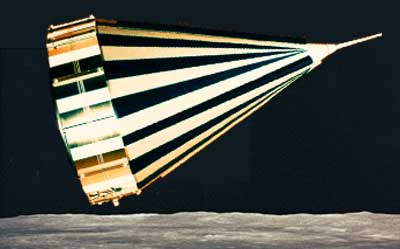Pioneer 3, 4 (original) (raw)

Pioneer 4 [NASA]
Pioneer 3 was a spin stabilized spacecraft launched by the U.S. Army Ballistic Missile agency in conjunction with NASA. The spacecraft failed to go past the Moon and into a heliocentric orbit as planned, but did reach a maximum altitude of over 102,000 km before falling back to Earth. The revised spacecraft objectives were to measure radiation in the outer Van Allen belt area using Geiger-Mueller tubes and to test the trigger mechanism for a lunar photographic experiment.
Pioneer 3 was a cone-shaped probe 58 cm high and 25 cm diameter at its base. The cone was composed of a thin fiberglass shell coated with a gold wash to make it electrically conducting and painted with white stripes to maintain the temperature between 10 and 50 degrees C. At the tip of the cone was a small probe which combined with the cone itself to act as an antenna. At the base of the cone a ring of mercury batteries provided power. A photoelectric sensor protruded from the center of the ring. The sensor was designed with two photocells which would be triggered by the light of the Moon when the probe was within about 30,000 km of the Moon. At the center of the cone was a voltage supply tube and two Geiger-Mueller tubes. A transmitter with a mass of 0.5 kg delivered a phase-modulated signal of 0.1 W at a frequency of 960.05 MHz. The modulated carrier power was 0.08 W and the total effective radiated power 0.18 W. A despin mechanism consisted of two 7 gram weights which could be spooled out to the end of two 150 cm wires when triggered by a hydraulic timer 10 hours after launch. The weights would slow the spacecraft spin from 400 rpm to 6 rpm and then weights and wires would be released.
The flight plan called for the Pioneer 3 probe to pass close to the Moon after 33.75 hours and then go into solar orbit. However, depletion of propellant caused the first stage engine to shut down 3.7 seconds early preventing the spacecraft from reaching escape velocity. The injection angle was also about 71 degrees instead of the planned 68 degrees. The spacecraft reached an altitude of 102,360 km (109,740 km from the center of the Earth) before falling back to Earth. It re-entered Earth's atmosphere and burned up over Africa on 7 December at approximately 19:51 UT (2:51 p.m. EST) at an estimated location of 16.4 N, 18.6 E. The probe returned telemetry for about 25 hours of its 38 hour 6 minute journey. The other 13 hours were blackout periods due to the location of the two tracking stations. The returned information showed that the internal temperature remained at about 43 degrees C over most of the period. The data obtained were of particular value since they indicated the existence of two distinct radiation belts.
Pioneer 4 was a spin stabilized spacecraft launched on a lunar flyby trajectory and into a heliocentric orbit making it the first US probe to escape from the Earth's gravity. It carried a payload similar to Pioneer 3: a lunar radiation environment experiment using a Geiger-Mueller tube detector and a lunar photography experiment. It passed within 60,000 km of the Moon's surface. However, Pioneer 4 did not come close enough to trigger the photoelectric sensor. No lunar radiation was detected. The spacecraft was still in solar orbit as of 1969.
Pioneer 4 was a cone-shaped probe 51 cm high and 23 cm in diameter at its base. The cone was composed of a thin fiberglass shell coated with a gold wash to make it electrically conducting and painted with white stripes to maintain the temperature between 10 and 50 degrees C. At the tip of the cone was a small probe which combined with the cone itself to act as an antenna. At the base of the cone a ring of mercury batteries provided power. A photoelectric sensor protruded from the center of the ring. The sensor was designed with two photocells which would be triggered by the light of the Moon when the probe was within about 30,000 km of the Moon. At the center of the cone was a voltage supply tube and two Geiger-Mueller tubes. A transmitter with a mass of 0.5 kg delivered a phase-modulated signal of 0.1 W at a frequency of 960.05 MHz. The modulated carrier power was 0.08 W and the total effective radiated power 0.18 W. A despin mechanism consisted of two 7 gram weights which spooled out to the end of two 150 cm wires when triggered by a hydraulic timer 10 hours after launch. The weights were designed to slow the spacecraft spin from 400 rpm to 6 rpm and then weights and wires were released.
After a successful launch Pioneer 4 achieved its primary objective (an Earth-Moon trajectory), returned radiation data and provided a valuable tracking exercise. The probe passed within 60,000 km of the Moon's surface (7.2 E, 5.7 S) on 4 March 1959 at 22:25 UT (5:25 p.m. EST) at a speed of 7,230 km/hr. The distance was not close enough to trigger the photoelectric sensor. The probe was tracked for 82 hours to a distance of 655,000 km and reached perihelion on 18 March 1959 at 01:00 UT. The cylindrical fourth stage casing (173 cm long, 15 cm diameter, 4.65 kg) went into orbit with the probe.